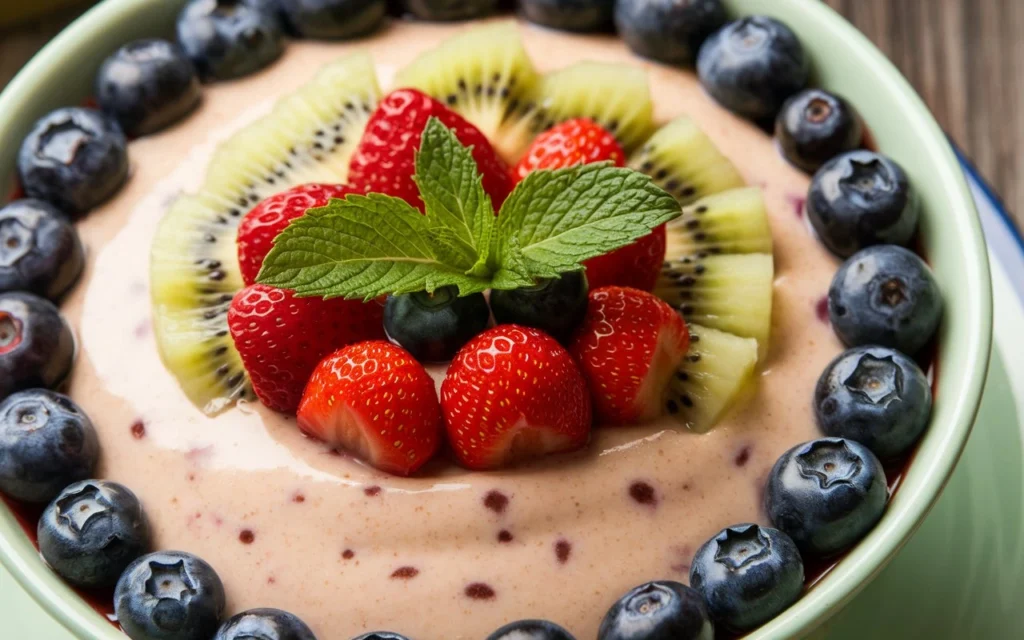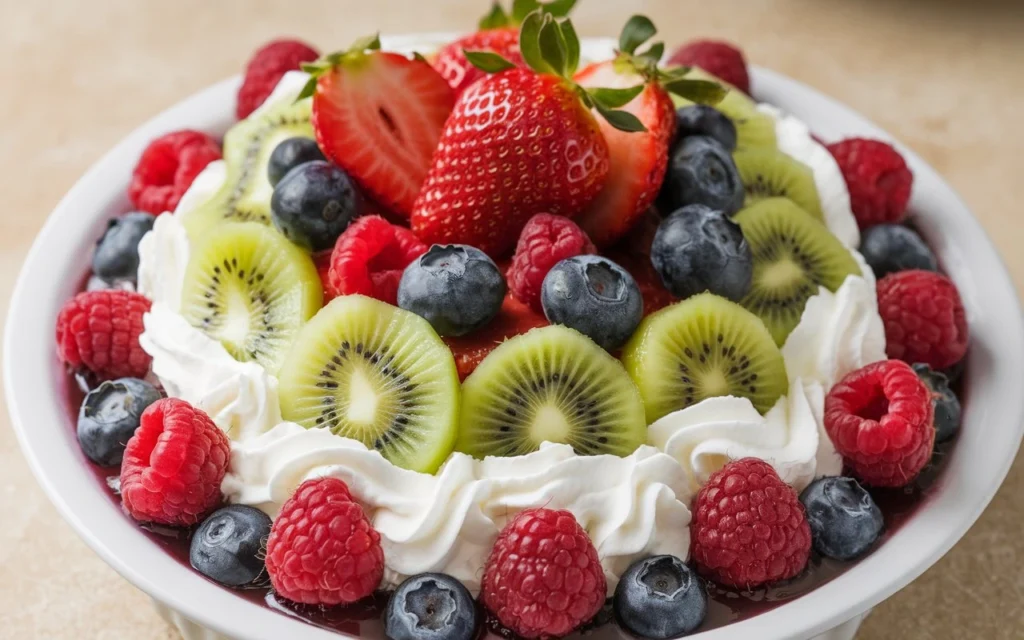Fruit Pudding: A Delicious Guide to History, Types, and Recipes
Fruit pudding is more than just a dessert — it’s a rich culinary tradition that spans centuries, continents, and tastes. From the classic Christmas pudding to the refreshing summer berry pudding, this versatile treat has evolved into a beloved staple on tables around the world. Packed with natural sweetness, vibrant colors, and comforting textures, fruit pudding can be served at holiday feasts, summer picnics, or as a wholesome after-dinner indulgence.
This article will take you on a flavorful journey, beginning with the origins of fruit pudding, exploring its most iconic types, and even touching on its health benefits. You’ll also learn how to create your own version at home. Ready to dive into the delightful world of fruit? Let’s get started!

Introduction to Fruit Pudding
What is Fruit Pudding?
Fruit pudding is a dessert made with fresh, dried, or preserved fruits mixed with other ingredients like bread, flour, oats, or custard. The mixture is often steamed, baked, chilled, or layered, depending on the type of pudding being made. Unlike creamy puddings like chocolate or vanilla, fruit puddings are chunkier, heartier, and more textured.
What makes pudding so special is its incredible versatility. It can be light and refreshing, like summer pudding, or dense and rich, like Christmas pudding. It can be sweet, savory, or a bit of both, as seen in the Scottish fruit pudding, which is often served with breakfast. With so many preparation styles, this dessert fits a wide range of tastes and occasions.
Why is Fruit Pudding So Popular?
The popularity of pudding lies in its ability to adapt to different flavors, ingredients, and dietary needs. It can be as simple as bread soaked in berry juice or as complex as a Christmas pudding steamed for hours and matured for weeks. This adaptability has kept fruit pudding relevant in kitchens worldwide.
It also plays an essential role in cultural celebrations. For example, Christmas pudding is more than a dessert — it’s a symbol of the holiday spirit. Families gather to prepare it weeks before Christmas, and traditions like hiding silver coins in the pudding have made it a cherished family ritual. Meanwhile, in Scotland, fruit pudding is a key part of the traditional breakfast plate, served alongside eggs and bacon.
How is Fruit Pudding Different from Other Puddings?
Unlike smooth puddings made with milk, sugar, and cornstarch, fruit puddings are more textured and hearty. Fruits, oats, bread, and dried fruits give them a denser feel. For example, Christmas pudding is steamed for hours, while summer pudding requires no cooking at all — it’s simply chilled until firm. The inclusion of fruit gives each bite a burst of flavor and natural sweetness, setting it apart from traditional puddings like vanilla or chocolate.
Historical Background of Fruit Pudding
Origins and Evolution
The origins of fruit pudding trace back to medieval England, where it began as a dish called “plum pottage.” Despite the name, “plum” was a term used for dried fruits like raisins, prunes, and currants — not fresh plums. Initially, fruit pudding was more savory than sweet. It included meat, grains, and spices, all cooked together into a thick, hearty stew.
Over time, sugar became more accessible, and the dish evolved from a savory meal to a sweet treat. By the 17th century, Christmas pudding had taken shape as a dense, sweet dessert packed with dried fruits, breadcrumbs, and warming spices like nutmeg and cinnamon. It was often steamed and aged for weeks before serving, giving it time to develop deep, rich flavors.
pudding eventually spread across Britain and beyond, with each region creating its own unique version. Scotland introduced its famous Scottish fruit pudding, while England perfected summer pudding. The influence of fruit pudding reached far-flung parts of the world, and to this day, it remains a cherished part of holiday meals, family gatherings, and everyday breakfasts.
Cultural Significance
The cultural significance of fruit pudding is undeniable, especially during Christmas. For centuries, families in Britain have made Christmas pudding weeks in advance, following the “Stir-up Sunday” tradition. On this day, family members would gather to stir the pudding mixture, each making a wish as they stirred. This ritual continues today, symbolizing togetherness and good fortune for the year ahead.
In Scotland, pudding is a part of the traditional breakfast, served alongside eggs, bacon, and black pudding. Unlike sweet desserts, Scottish pudding has a slightly sweet but hearty flavor. It’s prepared as a sausage-shaped loaf, then sliced and fried until golden brown. This makes it a filling, energy-packed breakfast staple designed to keep workers fueled throughout the day.
Across cultures, fruit pudding symbolizes comfort, celebration, and community. It’s a dessert that carries the weight of tradition and the warmth of family gatherings, which is why it remains beloved to this day.

Types of Fruit Puddings
Traditional Christmas Pudding
When people think of fruit pudding, Christmas pudding is often the first to come to mind. This rich, dense, and flavorful dessert combines dried fruits like raisins, currants, and cherries with breadcrumbs, suet, sugar, and warm spices like cinnamon and nutmeg. After mixing the ingredients, bakers press the mixture into a bowl or mold and steam it for several hours.
Unlike most desserts, people prepare Christmas pudding weeks (or even months) before Christmas. This early preparation allows the flavors to develop, while the texture becomes more tender and moist. On Christmas Day, families steam it once more and serve it warm. Some traditions involve pouring brandy over the pudding and lighting it on fire for a spectacular presentation. This dramatic display creates an unforgettable holiday moment that excites both children and adults.
Scottish Fruit Pudding
A “Full Scottish Breakfast” wouldn’t be complete without Scottish pudding. Unlike the sweet English versions, this pudding blends heartiness with a touch of sweetness. Cooks create it by mixing oatmeal, suet, dried fruits, flour, and spices into a dough-like consistency. They roll the mixture into a log shape and steam it until it becomes firm.
Once ready, cooks slice the pudding into thick rounds and fry it until golden brown on both sides. The crispy outside and soft, flavorful center make it a perfect addition to a classic Scottish breakfast. It pairs well with eggs, bacon, and black pudding, making it a filling meal that provides energy for the day.
Summer Pudding
If Christmas pudding represents the warmth of winter, summer pudding embodies the freshness of summer. Home cooks prepare this colorful dessert using fresh summer berries like strawberries, raspberries, and blackberries. To make it, they simmer the berries until they release their juices, then soak bread slices in the vibrant berry juice.
Next, they layer the juice-soaked bread with whole berries in a bowl or mold. After pressing the mixture down, they chill it until it firms up. When flipped onto a plate, it reveals a vibrant, colorful dome of berry-soaked bread and juicy fruit. Its natural sweetness and fresh flavors make summer pudding a popular choice for picnics, barbecues, and summer celebrations.
Modern food trends have inspired many new versions of fruit pudding, making it more inclusive for people with different dietary needs. Today, bakers and home cooks alike create versions that are vegan, gluten-free, and sugar-free. Here are some of the most popular modern variations:
Modern Variations of Fruit Pudding
- Chia Seed Fruit Pudding: People soak chia seeds in almond milk or coconut milk to create a creamy, pudding-like texture. They layer fresh fruits like bananas, berries, or mangoes into the pudding, making it a nutrient-dense breakfast or snack option.
- Vegan Pudding: To make a vegan version, bakers replace suet with coconut oil or vegan butter. This change allows people following a plant-based diet to enjoy the same rich taste and texture as traditional puddings.
- Gluten-Free Fruit Pudding: Cooks replace traditional flour with almond flour, coconut flour, or gluten-free flour blends. This change lets people with gluten intolerance enjoy fruit pudding without compromising taste or texture.
With these creative options, pudding continues to evolve, offering something for every lifestyle. People around the world can now enjoy it as a festive treat, a healthy breakfast, or a guilt-free dessert.
Nutritional Aspects of Fruit Pudding
Health Benefits of Pudding
Fruit pudding isn’t just a tasty treat — it also offers a variety of health benefits. Fresh and dried fruits, often key ingredients in these puddings, provide vitamins, antioxidants, and fiber. Berries in summer pudding supply plenty of vitamin C, which strengthens the immune system and promotes healthier skin. They also contain antioxidants that reduce inflammation and protect cells from damage.
Dried fruits, like raisins and prunes found in Christmas pudding, offer another set of health benefits. They contain dietary fiber, which supports healthy digestion and promotes regular bowel movements. Fiber also slows the absorption of sugar into the bloodstream, helping to maintain stable blood sugar levels.
Chia seed puddings, a modern twist on fruit pudding, pack a powerful nutritional punch. Chia seeds are rich in omega-3 fatty acids, protein, and fiber, all of which support heart health and aid in digestion. Since chia seeds absorb liquid and swell, they create a filling, gel-like texture that leaves people feeling full for longer. Many people now enjoy chia seed puddings as a healthy breakfast or post-workout snack.
By making small changes to traditional recipes, home cooks can boost the nutritional profile of fruit pudding. For instance, reducing added sugar and incorporating more fresh fruits can turn a calorie-dense dessert into a more wholesome, nutrient-dense option.
Considerations for a Balanced Diet
While fruit has many health benefits, certain traditional versions may contain more sugar and fat than modern diets recommend. Recipes like Christmas pudding and Scottish fruit pudding use suet (a type of animal fat) to achieve a moist, rich texture. However, since suet is high in saturated fat, consuming it in large amounts may impact heart health.
Sugar is another ingredient to watch. Dried fruits already contain natural sugars, but traditional recipes often add more sugar to enhance sweetness. For those seeking healthier options, modern fruit pudding recipes reduce sugar by using fresh fruits or natural sweeteners like honey, maple syrup, or date syrup. The natural sweetness from bananas or ripe berries can also eliminate the need for added sugar.
New versions of pudding now cater to different dietary preferences. People following vegan diets can swap out suet for coconut oil or plant-based butter. Gluten-free versions use alternative flours like almond or coconut flour, which add nutrients and flavor without sacrificing texture. These ingredient swaps allow health-conscious eaters to enjoy fruit pudding without guilt.
By focusing on fresh fruits, healthy fats, and natural sweeteners, people can transform fruit pudding into a balanced, everyday dessert. Whether you enjoy a traditional Christmas pudding during the holidays or a refreshing chia seed fruit pudding for breakfast, this classic treat can fit into a healthy lifestyle.
FAQs Section
What is the origin of fruit pudding?
Fruit pudding began as “plum pottage” in medieval England, a savory dish with meat, grains, and dried fruits. Over time, it evolved into the sweet, fruit-filled puddings enjoyed today.
How is Scottish fruit pudding prepared?
Cooks combine oatmeal, dried fruits, suet, and spices to form a dense mixture, which they roll into a log. After steaming it until firm, they slice it into thick rounds and fry them until golden brown.
Can fruit pudding be made vegan?
Yes! To create a vegan fruit pudding, cooks replace suet with coconut oil or vegan butter. They also swap dairy milk with almond, soy, or coconut milk, making it plant-based and delicious.
What fruits are commonly used in summer pudding?
Fresh berries like strawberries, raspberries, blackberries, blueberries, and redcurrants are the most common fruits in summer pudding. These berries release their vibrant juices, soaking the bread and giving the pudding its colorful, fruity layers.
Is Christmas pudding the same as fruit pudding?
Christmas pudding is a type of pudding, but not all fruit puddings are Christmas puddings. Whilepudding refers to any dessert made with fruit, Christmas pudding is a specific version enjoyed during the holidays.
How can I reduce the sugar content in fruit pudding?
To lower sugar content, swap refined sugar for natural sweeteners like honey, maple syrup, or dates. Fresh fruits like bananas or berries can also add natural sweetness, reducing the need for extra sugar.
Conclusion
Fruit pudding is a timeless dessert that has delighted people for centuries. From its medieval origins as “plum pottage” to its evolution into iconic dishes like Christmas pudding and Scottish fruit pudding, this dish has adapted to every era and diet. Today, people continue to enjoy pudding in its many forms — from rich, holiday-style puddings to light, no-bake berry puddings.
Its ability to adapt to dietary needs, such as vegan, gluten-free, and low-sugar versions, keeps it relevant. People can now enjoy pudding as part of a hearty breakfast, a healthy snack, or a festive holiday dessert. No matter how it’s prepared, fruit pudding remains a symbol of warmth, comfort, and culinary tradition.
With its rich flavors, long history, and endless variety, fruit pudding continues to be a treasured dish that satisfies sweet cravings while bringing people together at the table.


